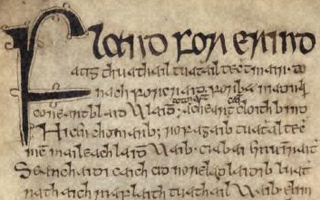Related Research Articles

The Annals of Ulster are annals of medieval Ireland. The entries span the years from 431 AD to 1540 AD. The entries up to 1489 AD were compiled in the late 15th century by the scribe Ruaidhrí Ó Luinín, under his patron Cathal Óg Mac Maghnusa, on the island of Senadh-Mic-Maghnusa, also known as Senad or Ballymacmanus Island, near Lisbellaw, on Lough Erne in the kingdom of Fir Manach (Fermanagh). Later entries were added by others.
Áed mac Néill, called Áed Findliath to distinguish him from his paternal grandfather Áed Oirdnide, was king of Ailech and High King of Ireland. He was also called Áed Olach according to Baile in Scáil, section 51. A member of the northern Uí Néill kindred of the Cenél nEógain, Áed was the son of Niall Caille.
Ruarc mac Brain was the fourth of ten Kings of Leinster to be inaugurated and based on Lyons Hill, Ardclough, County Kildare, a member of the Uí Dúnchada, one of three septs of the Uí Dúnlainge dynasty which rotated the kingship of Leinster between 750 and 1050, significant in County Kildare History.

Flann mac Máel Sechnaill, better known as Flann Sinna, was the son of Máel Sechnaill mac Máele Ruanaid of Clann Cholmáin, the leading branch of the Southern Uí Néill. He was King of Mide from 877 onwards and a High King of Ireland. His mother Land ingen Dúngaile was a sister of Cerball mac Dúnlainge, King of Osraige.
Máel Sechnaill mac Máel Ruanaida, also known as Máel Sechnaill I, anglicised as Malachy MacMulrooney was High King of Ireland. The Annals of Ulster use the Old Irish title rí hÉrenn uile, that is "king of all Ireland", when reporting his death, distinguishing Máel Sechnaill from the usual Kings of Tara who are only called High Kings of Ireland in late sources such as the Annals of the Four Masters or Geoffrey Keating's Foras Feasa ar Éirinn. According to the "Grand History of the Celts", a traditional book of facts and folklore, Mael Sechnaill was the husband of Mael Muire, the granddaughter of the legendary Alpin, a 9th-century king of Dalriada.
Auisle or Óisle was a Viking leader in Ireland and Scotland in the mid-late ninth century. He was the son of the king of Lochlann, identified in the non-contemporary Fragmentary Annals of Ireland as Gofraid, and brother of Amlaíb Conung and Ímar, the latter of whom founded the Uí Ímair dynasty, and whose descendants would go on to dominate the Irish Sea region for several centuries. Another Viking leader, Halfdan Ragnarsson, is sometimes considered a brother. The Irish Annals title Auisle, Ímar and Amlaíb "kings of the foreigners". Modern scholars use the title "kings of Dublin" after the Viking settlement which formed the base of their power.
Cináed mac Conaing was King of Knowth in the medieval Irish province of Mide, succeeding his father Conaing mac Flainn in 849.
Ólchobar mac Cináeda was King of Munster from 847 until his death. He may be the "king of the Irish" who sent an embassy to Frankish Emperor Charles the Bald announcing a series of victories over Vikings in Ireland in 848.
Conchobar mac Taidg Mór was a King of Connacht from the Uí Briúin branch of the Connachta. He was the grandson of Muirgius mac Tommaltaig, a previous king. His father Tadg Mór had been slain fighting in Muirgius' wars versus the minor tribes of Connacht. He was of the Síl Muiredaig sept of the Uí Briúin. The Ó Conchobhair septs of Connacht are named for him.
Máel mac Donngaile, known as Máel Gualae, was a King of Munster from the Eóganacht Chaisil branch of the Eoganachta, the ruling dynasty of Munster. He was of the Clann Faílbe sept of this branch and a grandson of Tnúthgal mac Donngaile, whom some sources name as King of Munster and brother of Áilgenán mac Donngaile, also King of Munster. His branch of the ruling dynasty had their lands in the Cashel area of modern County Tipperary. He reigned from 856 to 859.
Cenn Fáelad hua Mugthigirn was a King of Munster of the Eoganachta, the ruling dynasty of Munster. He ruled from 861-872. He was also abbot of Emly from 851-872, an important monastery in County Tipperary where he succeeded a previous King of Munster, Ólchobar mac Cináeda.
Matudán mac Muiredaig was a Dál Fiatach king of Ulaid, which is now Ulster, Ireland. He was the son of Muiredach mac Eochada, the previous king. He ruled from 839-857.
Events from the 9th century in Ireland.
Events from the 10th century in Ireland.
Máel Ruanaid mac Donnchada Midi was a King of Uisnech in Mide of the Clann Cholmáin. He was the son of the High King of Ireland, Donnchad Midi and brother of the high king Conchobar mac Donnchada. He ruled in Uisnech from 833-843.
Lorcán mac Cathail was a King of Uisnech and Mide of the Clann Cholmáin. Lorcán ruled in as King of Mide from 862–864.
Muirgeas ua Cú Ceanainn was King of Uí Díarmata.
Mughron Ua Níoc was Abbot of Tuam.
Litan was abbot of Tuam.
Dúngal mac Fergaile was king of Osraige from 802 until his death in 842.
References
- Annals of Ulster at CELT: Corpus of Electronic Texts at University College Cork
- Annals of Tigernach at CELT: Corpus of Electronic Texts at University College Cork
- Revised edition of McCarthy's synchronisms at Trinity College Dublin.
- Byrne, Francis John (2001), Irish Kings and High-Kings, Dublin: Four Courts Press, ISBN 978-1-85182-196-9